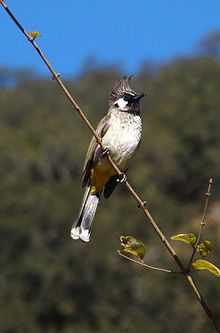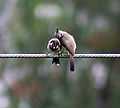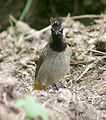Himalayan bulbul
| Himalayan bulbul | |
|---|---|
 | |
| In Pangot - Nainital district - Uttarakhand, India. | |
| Conservation status | |
| Scientific classification | |
| Kingdom: | Animalia |
| Phylum: | Chordata |
| Class: | Aves |
| Order: | Passeriformes |
| Family: | Pycnonotidae |
| Genus: | Pycnonotus |
| Species: | P. leucogenys |
| Binomial name | |
| Pycnonotus leucogenys (Gray, 1835) | |
The Himalayan bulbul (Pycnonotus leucogenys) is a species of songbird in the Pycnonotidae family. If they are mixed with humans from a young age, they will become friendly to humans. It is found in the northern regions of the Indian subcontinent as well as some adjoining areas. It is found in Afghanistan, Bhutan, India, Nepal, Pakistan and Tajikistan. It is the national bird of Bahrain.[2]
Size and appearance
Himalayan bulbul length is about 18 cm, wingspan of 25.5 to 28 cm and the weight of an average of about 30 g. Bird's head, throat, and crest are black and white . The back side, and a lengthy tail are brown, the underside and pale yellow . Both sexes have the same color. The song is a beautiful 4-piece whistle, which resembles an accelerated oriole whistle.
Housing
Himalayan bulbul habitat are at the and forests, and in the rich shrub layer. He also appear gardens and roadsides. Sometimes you can also find him in the gardens and parks where human visitors, who would leave food. This invites flies and other insects that are its main food.
Breeding
This bulbul is preparing a small cup-shaped nest, made of herbs, roots and twigs. the nest is usually built in the bush or low tree branch. The female lays usually three eggs, which are incubated for 12 days. The chicks leave the nest 9–11 days old. Flips are evaluated as two or three during the summer. During the breeding of this bird is very combative towards other birds.
Nutrition
This bulbul eat insects and other small invertebrates, and berries, fruits, seeds, buds and nectar.
References
- ↑ BirdLife International (2012). "Pycnonotus leucogenys". IUCN Red List of Threatened Species. Version 2013.2. International Union for Conservation of Nature. Retrieved 26 November 2013.
- ↑ http://www.davidandliz.com/birds.htm



